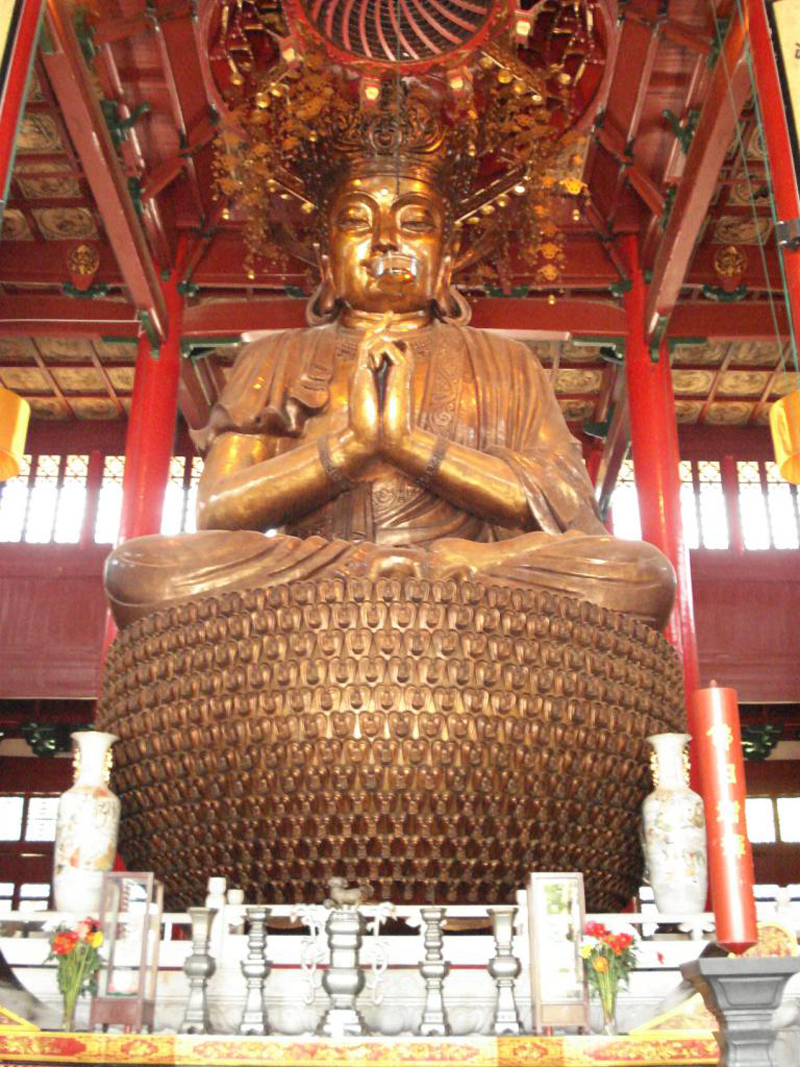Jingci Temple is located at the foot of Huiri Peak of Nanping Hill in Hangzhou, Zhejiang Province. It is the second prominent Buddhist temple around West Lake together with Lingyin Temple. Named the jewel of the southern and northern hills , the temple in 1983, was listed as a national key Buddhist temple in Han's area by the State Council. Jingci Temple proudly hosts one of Ten Top Scenic Spots of West Lake --- "Evening Bell Ringing at the Nanping Hill".
The Main Shrine Hall: Jingci Temple was initially called Huiri Yongming Temple. It was first built in 954AD by Emperor Wuyue for a famous monk, Yongming. During the North Song Dynasty, its name was changed to Shouning Chan Temple. And finally, during the South Song Dynasty, the name was changed again, to what we call it today --- Jingci Temple. During this time, the 500 Luohan Halls were built. Like many ancient structures, the temple was destroyed and rebuilt several times during itshistory. It has a newly forged copper bell, weighing over 100 kilograms. Upon it is carved The Lotus Sutr, with 68,000 characters. Many famed Buddhist monks used to stay and meditate in this monastery.

Nan Ping Wan Zhong: Now the temple consists of three big halls, placed respectively in the front, middle and back. The Main Shrine Hall is in the middle. In the west of the Main Shrine Hall is Jizu Hall, in front of which there is an ancient well which possesses an curiously simple, but popular attraction. A large piece of wood floating on the surface of the water lies in the well. It was allegedly left by Master Ji when he used his superhuman power to carry wood past the well to build the temple. According to the account of Ci Si Zhi, Master Ji entered into religion at the Lingyin Temple, but later he moved to Jingci Temple where he lived for the rest of his life.
There is a stele pavilion inscribed with four big characters "Nan Ping Wan Zhong" on the right side of the temple's gate. The Evening Bell Ringing at the Nanping Hill is struck here every day. The bell has a long standing renown in the history of the Jingci Temple. The poet Zhang Dai from the Tang Dynasty described the ring of the bell as, "The night air is in the Nanping Hill, the wind is as thin as paper, the bell ring emerged from the top, the night air crossing the river." The huge bell weighs about 20,000 Jin (斤), and was cast during the Ming Taizu Hongwu Period (1368 – 1398). When evening comes, and the sun falls to the west, the bell echoes across the mountains and clear blue sky. As there are many grotesque caves and caverns on Nanping Hill, the echo of the bell resounds deep into the rocks, causing the bell ring to spread more than 10 miles away.
Wood Carrying Ancient Well: It is said that Emperor Kangxi had visited the top ten views in West Lake. He built many pavilions, including the stele pavilion of Nan Ping Wan Zhong. Unfortunately, in the late Qing dynasty, the bronze bell had tragically disappeared during the chaos of war, and people were not able to hear its familiar ring. Not until October 1984, was the bronze bell recast under the guidance of Buddhist circles in Japan. In recent years, on every New Year, Hangzhou locals, foreign guests, overseas Chinese and other visitors can gather in, and outside, the bell tower of Jingci Temple to take their turn at striking the bell. When 108 bell rings have pealed, New Year has officially arrived. This event symbolizes peace, happiness, stability and unity, and it breathes new meaning and charm into the ancient Evening Bell Ringing ritual at Nanping Hill.
